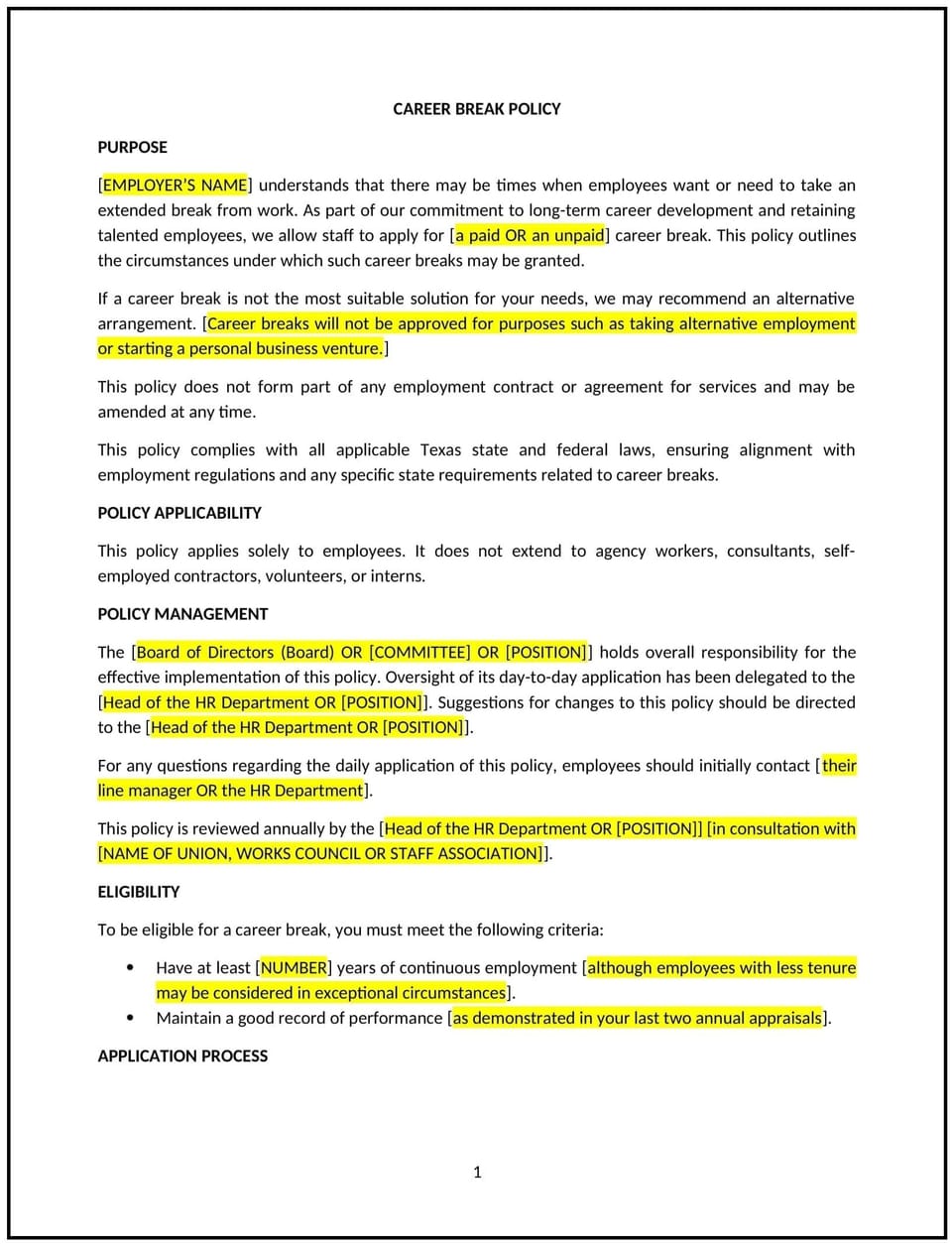Career break policy (Texas): Free template

Career break policy (Texas)
This career break policy is designed to help Texas businesses establish clear guidelines for employees who wish to take an extended break from their employment for personal, educational, or other life reasons. Whether businesses are managing requests for unpaid leave or allowing employees time away to pursue personal development, this template provides a structured approach to managing career breaks while maintaining business continuity.
By adopting this template, businesses can offer flexible options to employees while ensuring that key roles are covered and the business operates smoothly during extended absences.
How to use this career break policy (Texas)
- Define eligibility: Specify the criteria for employees to qualify for a career break, such as length of employment, job performance, and the reasons for taking a break (e.g., personal development, travel, education).
- Set the duration of career breaks: Clearly outline the maximum length of time an employee can take for a career break, specifying whether it is a fixed period (e.g., six months) or flexible based on individual circumstances.
- Address unpaid leave: Explain whether career breaks are paid or unpaid, and outline the benefits (if any) that will continue during the break, such as health insurance or retirement contributions.
- Set approval procedures: Detail the process for applying for a career break, including the required notice period, documentation (e.g., reason for the break), and the decision-making process.
- Define job protection: Explain whether the employee's position will be held during the career break and the process for re-entry into the workforce after the break, including the possibility of job reassignment or changes to job responsibilities.
Benefits of using this career break policy (Texas)
This policy offers several benefits for Texas businesses:
- Supports employee work-life balance: A career break policy provides employees with the flexibility to take time off for personal or professional development, leading to greater job satisfaction and well-being.
- Increases employee retention: Offering career breaks as an option can help businesses retain valuable employees by giving them the opportunity to step away from work without permanently losing their position.
- Enhances productivity and engagement: Employees who return from a career break refreshed and with new experiences may be more engaged, productive, and loyal to the company.
- Provides a competitive advantage: A career break policy can be an attractive benefit that sets a business apart from competitors in the job market, particularly for employees seeking flexibility.
- Reduces turnover: By offering employees the option of a career break, businesses can reduce the risk of losing top talent to other employers offering similar benefits.
Tips for using this career break policy (Texas)
- Communicate the policy clearly: Ensure that all employees are aware of the career break policy and understand the eligibility criteria, application process, and any terms and conditions for taking a break.
- Plan for coverage: Ensure that appropriate measures are in place to cover the employee's responsibilities during their absence, such as temporary staffing or redistributing tasks to other team members.
- Monitor the employee’s return: Clearly outline the process for the employee’s return to work, including discussions about re-entry, job roles, and expectations.
- Be flexible: While the policy sets certain guidelines, be flexible in accommodating individual needs and circumstances, especially in cases where employees need to extend or adjust their break duration.
- Review regularly: Update the policy periodically to reflect changes in Texas state laws, business operations, or employee feedback regarding career breaks.
Q: Who is eligible for a career break under this policy?
A: Employees who have been with the company for a certain period (e.g., one year or more) and meet the required performance standards may be eligible to apply for a career break. The policy should specify the criteria for eligibility.
Q: Is a career break paid or unpaid?
A: The policy should specify whether career breaks are paid or unpaid. Typically, career breaks are unpaid, but businesses may offer continued benefits, such as health insurance, during the break.
Q: How long can an employee take a career break?
A: The policy should define the maximum duration of a career break, which can range from a few months to a year, depending on the business’s needs and the reasons for the break.
Q: How should employees apply for a career break?
A: Employees should apply for a career break by submitting a formal request to their supervisor or HR, providing details of the reason for the break and any necessary documentation. The policy should outline the application process and the required notice period.
Q: Will my job be held during the career break?
A: The policy should specify whether the employee’s job will be protected during the break or if there will be any changes to the employee’s position upon their return. In some cases, employees may be offered a similar or modified role.
This article contains general legal information and does not contain legal advice. Cobrief is not a law firm or a substitute for an attorney or law firm. The law is complex and changes often. For legal advice, please ask a lawyer.


